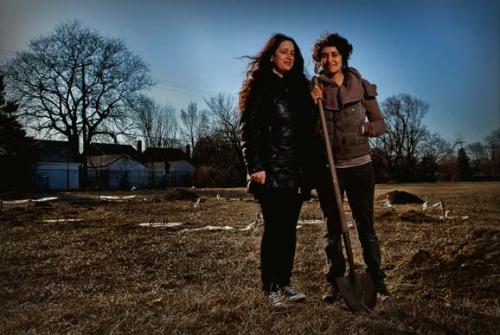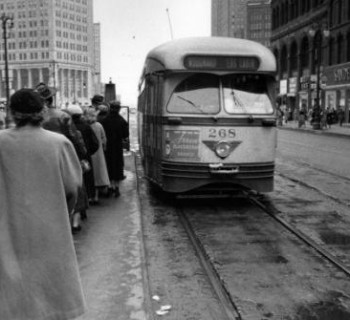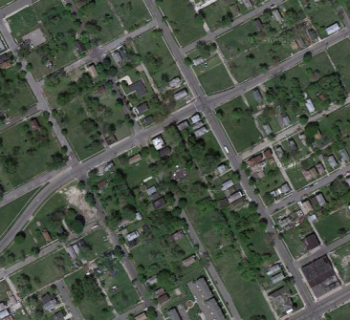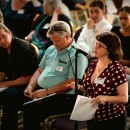DETROIT—Calimera Park is in the Osborn neighborhood. It's one of 10 in the neighborhood and not unlike nearly every other park in the city. In cash-strapped Detroit, it's up to the community to maintain its parks' grounds and equipment. And this was before Mayor Bing announced plans to cease maintenance on 51 city parks and cut back services on 36 more.
Calimera Park wasn't included in that list of 87 parks. Other parks in the Osborn neighborhood were, with Wish Egan Field set to receive less maintenance and Beland Manning and Marruso parks scheduled to get the axe altogether.
The idea of a neighborhood having to take care of its own parks is nothing new.
“Calimera Park is still a tier one park, and it's not going to close,” said Wayne Ramocan, program coordinator for the Osborn Neighborhood Alliance. “But the city wasn't really taking care of it anyhow.”
Instead, it's been a combination of institutions, organizations and members of the community who have banded together to leverage the neighborhood's built environment and foster a sense of place in Calimera Park. Once that's accomplished, the Osborn Neighborhood Alliance plans to take its successes at Calimera and spread out from there.
“We want to connect Calimera to something else. We don't want a stand-alone oasis. We want to tie in other things to the park and come up with a comprehensive plan for the neighborhood as a whole,” said Wayne. “But this is where we're starting. We're setting our flag in the ground.”
That flag is the Edible Hut.
 The Edible Hut is a sort of living gazebo, a shelter and community space with an impressive garden of edible perennials growing on the roof. Designed by local artists Kate Daughdrill and Mira Burack along with input from local residents, the Edible Hut will anchor Calimera as a performance space, learning experience, and recreation area. Construction is set to begin at the end of April or early May.
The Edible Hut is a sort of living gazebo, a shelter and community space with an impressive garden of edible perennials growing on the roof. Designed by local artists Kate Daughdrill and Mira Burack along with input from local residents, the Edible Hut will anchor Calimera as a performance space, learning experience, and recreation area. Construction is set to begin at the end of April or early May.
The actual structure of the hut will be re-purposed out of a garage Kate acquired in southwest Detroit. Kate built her neighbor a fence in return for the garage. Kate and Mira received help from a group of Osborn youths to restore and paint the panels. The two artists have been collaborating with a company called LiveRoof to pick the proper plants for up top.
“We're thinking about texture, height, color, and the different times when things will bloom,” said Mira. “There's a science and an art to the whole thing. It's like making a collage with plants.”
The original idea for the Edible Hut came not from the artists but residents of the Osborn neighborhood.
For the past six years, Community + Public Arts Detroit, developed at College for Creative Studies and funded by the Kresge Foundation, the Chase Foundation, and the Skillman Foundation, has been working with the six neighborhoods of the Skillman Good Neighborhoods Initiative to commission public art works that meet the needs of each neighborhood. Rather than commission works that come from an artist's individual vision, C+PAD first asks neighborhoods what they want, and then facilitates and funds the process of finding artists who can meet those needs.
“We go to the community and ask the community what are some of the challenges in the community right now, or what are some of the opportunities in the community right now,” said Mikel Bresee, director of C+PAD.
Mikel cited the neighborhood's stated desire for a shelter in the park to go along with an already existing theme of healthy food education and activities. C+PAD pitched artists' submissions to the Osborn neighborhood and the neighborhood picked which project they wanted.
“The hut gives a different perspective,” said Wayne. “It brings fun into getting outside, living a healthy life, eating healthy. And then we can combine it with other fun activities like performances and learning activities like knitting and craft-making.”
Kate and Mira were introduced to each other through mutual friends in June 2011. They got to work on the project immediately.
“People kept telling me that I needed to meet Kate,” said Mira.
“People kept telling me that I needed to meet Mira,” said Kate.
“Literally within 10 minutes of meeting each other, I asked her if she wanted to apply for the grant and 30 minutes later we had the idea,” said Mira. “Everything occurred naturally and that doesn't always happen with collaborations.”
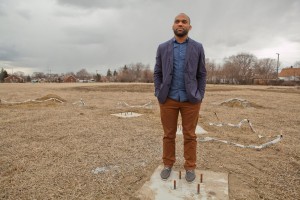 The length of time between winning the grant in June 2011 and beginning the assembly this spring has been trying but constructive, too. The amount of time it took the city to approve the hut's permits could have dissuaded anyone, but C+PAD the artists, and most importantly the neighborhood made sure that the project would not die a slow death in the depths of bureaucracy.
The length of time between winning the grant in June 2011 and beginning the assembly this spring has been trying but constructive, too. The amount of time it took the city to approve the hut's permits could have dissuaded anyone, but C+PAD the artists, and most importantly the neighborhood made sure that the project would not die a slow death in the depths of bureaucracy.
“It was just a horror show,” said Mikel. “And the thing that really got the permits in the end was the fact that the community petitioned the city council. Kate and Mira didn't petition city council. College for Creative Studies didn't petition city council. The Osborn neighborhood themselves petitioned city council.”
“We're very relieved that the city permits were passed,” said Wayne. “You could tell it was hard on Kate and Mira.”
“It took one and a half years to get permission from the city,” said Mira. “You could get frustrated waiting that long to actualize the project. But it's worked out because it's taken that long to get to know the people in the community. We really had to hang in there and keep the positive momentum going.”
“Building that infrastructure among the people mirrors the physical infrastructure of the hut,” said Kate.
Mikel cites that infrastructure when singing the praises of Kate and Mira's engagement with the community. He says that of the 22 projects C+PAD has been a part of, Kate and Mira's relationship with the neighborhood has been one of the most rewarding and genuine.
“In this area of community engagement, it's natural and authentic to Kate and Mira,” said Mikel. “Authentic is a part of their process.”
 Instead of sitting on their thumbs and waiting for the permits to come through, Kate and Mira used that time to better connect with the residents of the Osborn neighborhood. Simple acts such as bringing a camping stove to the park and making crepes and quesadillas with residents created a deeper dialog. A performance series with local musicians was also started last fall, and all sides hope to make this an annual tradition.
Instead of sitting on their thumbs and waiting for the permits to come through, Kate and Mira used that time to better connect with the residents of the Osborn neighborhood. Simple acts such as bringing a camping stove to the park and making crepes and quesadillas with residents created a deeper dialog. A performance series with local musicians was also started last fall, and all sides hope to make this an annual tradition.
The Edible Hut will be built next to the Memory Field, a previous installation commissioned by C+PAD Created by Graem Whyte, the Memory Field is an earthwork intended as a memorial for the Osborn neighborhood's deceased residents. It's also functional, as it collects water into a 1,700 gallon underground cistern for use in the park's community garden.
The nearby Nsoroma Institute has garden boxes in Calimera Park, as they have a strong interest in food stability and sustainability. The school had a lot of input in choosing the Edible Hut.
“This is a good space without the the hut, but it'll be great with the hut,” said Wayne.
The residents of Osborn know it, too, he said.
“They're excited to see what it looks like, feels like, and how we use it.”


